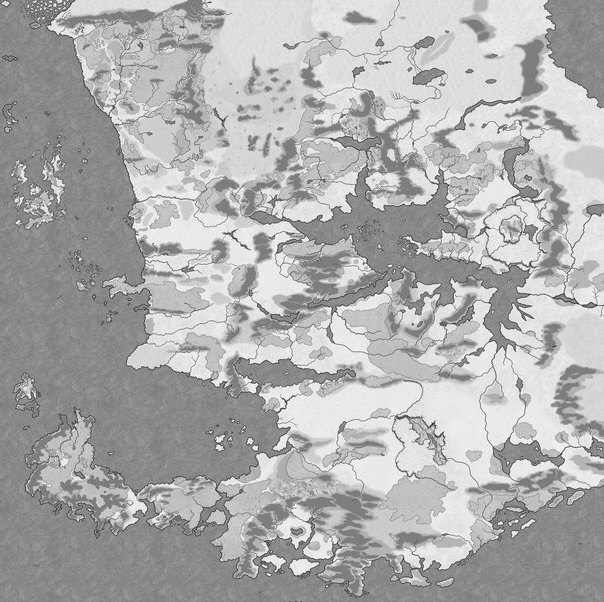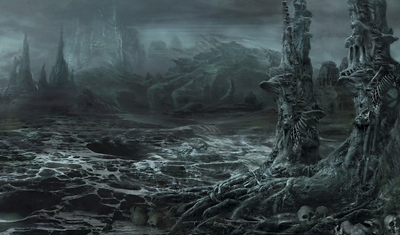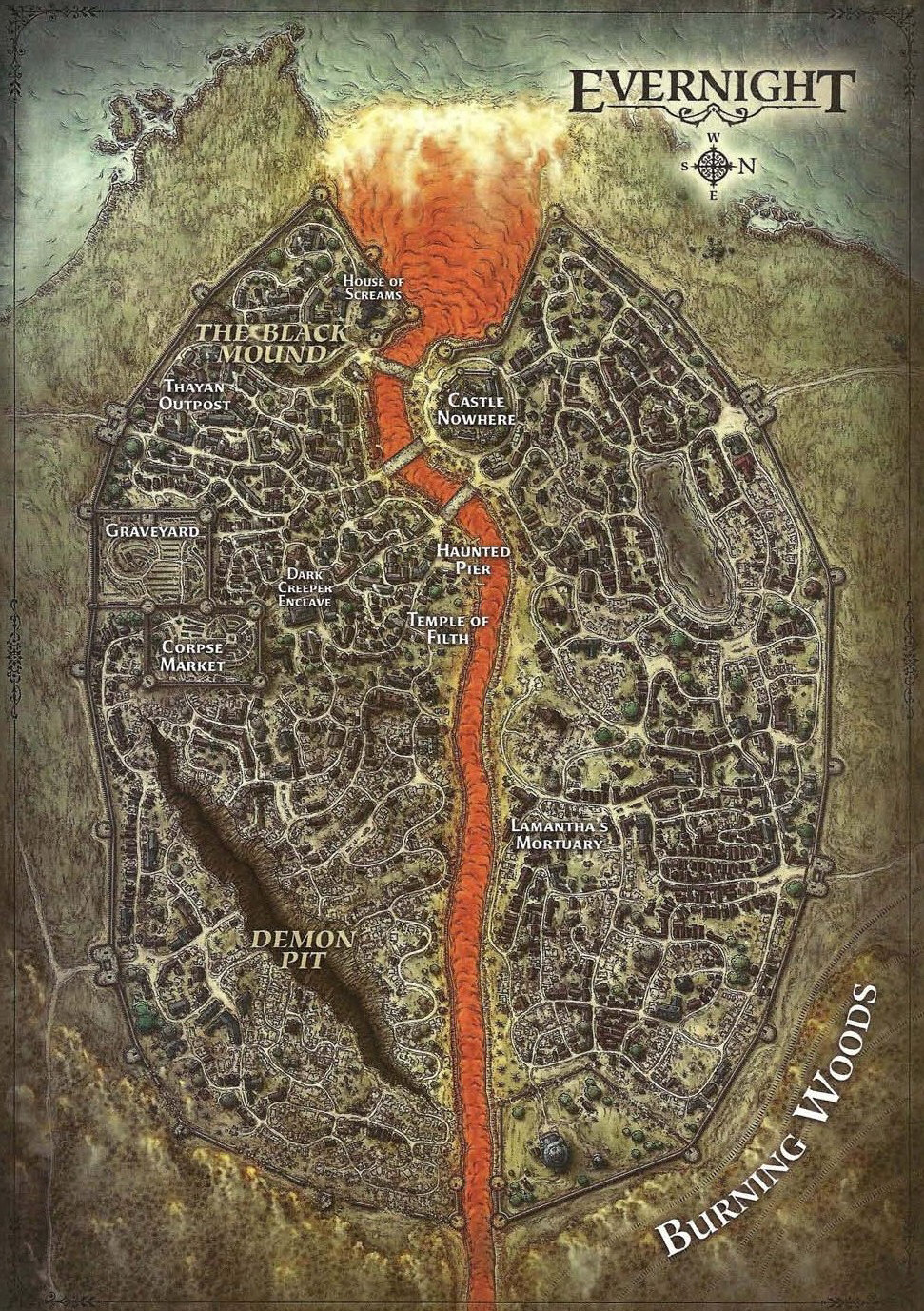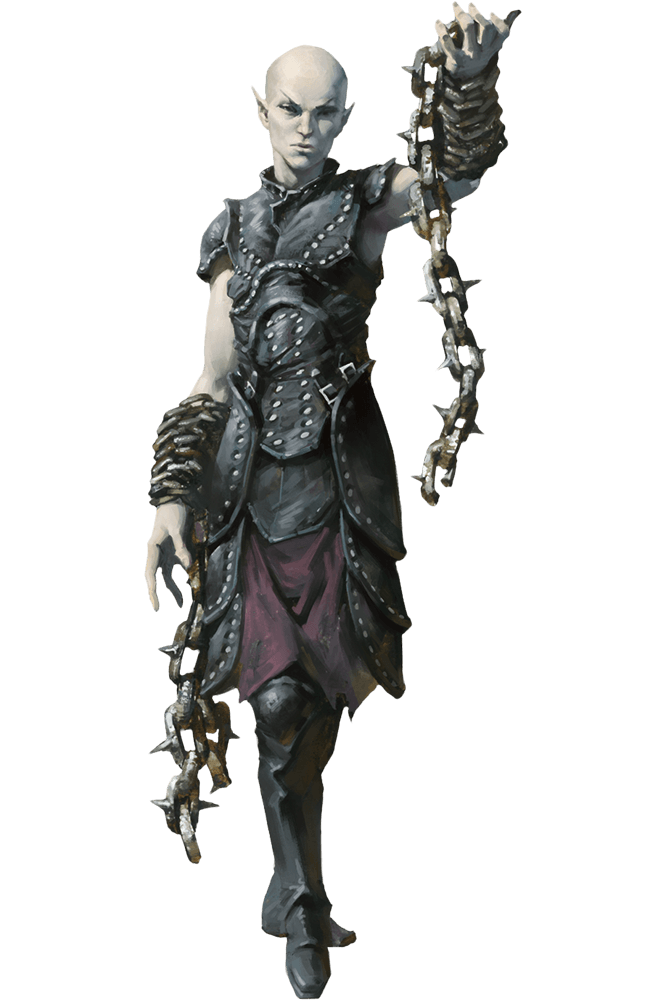The Shadowfell is a parallel to Toril in the sense that it is a reflection, or “echo”, of the people and places of that Prime Material Plane. As the opposite of the magical faerie land of the Feywild, the Shadowfell is a bleak, desolate place full of decay and death. Once, very little was known about what was called the Plane of Shadow, other than it was a dim and dismal place. Following the events of the Second Sundering, scholars on Toril now understand that the Shadowfell is one third of the parallel planes, coexisting with the Material Plane and Feywild.
Shadowfell is a parallel to Toril in the sense that it is a reflection, or “echo”, of the people and places of that Prime Material Plane. As the opposite of the magical faerie land of the Feywild, the Shadowfell is a bleak, desolate place full of decay and death. Once, very little was known about what was called the Plane of Shadow, other than it was a dim and dismal place. Following the events of the Second Sundering, scholars on Toril now understand that the Shadowfell is one third of the parallel planes, coexisting with the Material Plane and Feywild.
Description
The most striking and immediate impression a visitor to the Plane of Shadow experiences is the lack of color and light; no sun, moon, or stars adorned the vault of the inky black sky, and all things looked as if the color had leeched out, leaving nothing but black and white, which in the dimness were more like “dark black” and “light black”. A light source only illuminates half the distance it normally would, flames and fires put out less heat, and spells that deal with light or fire are less predictable and prone to failure… whereas shadow spells are enhanced. On the other hand, although it does not illuminate as far, any light source on the plane can be spotted at a distance of up to ten times its normal range of illumination, such is the contrast to the constant gloom, similar to a star in the night sky. Even a light source that only puts out shadowy illumination, like a darkness spell or a lantern burning shadowlight oil, can be seen up to five times its range of illumination.
 Because the Shadowfell is magically morphic (and divinely morphic in the realms of Shar and Mask), the landscape is a dark, twisted echo of what exists on Toril. Upon entering the Plane of Shadow, the local features are usually quite similar: casting shadow walk in a forest puts you in a shadow forest; casting it under water drops you in a similar body of water, etc. But from that starting point, the landscape diverges rapidly away from the familiar, and on subsequent visits from the same starting point, it may diverge in different ways, making mapping the Shadowfell a useless endeavor. Landmarks are usually recognizable but altered in some bizarre way: buildings might be constructed in a different style, built with different materials, at a different location, and/or in any condition from dilapidated ruins to its normal appearance, for example, or otherwise strange and distorted. Similar sites are sometimes called “shadow-analogues.”
Because the Shadowfell is magically morphic (and divinely morphic in the realms of Shar and Mask), the landscape is a dark, twisted echo of what exists on Toril. Upon entering the Plane of Shadow, the local features are usually quite similar: casting shadow walk in a forest puts you in a shadow forest; casting it under water drops you in a similar body of water, etc. But from that starting point, the landscape diverges rapidly away from the familiar, and on subsequent visits from the same starting point, it may diverge in different ways, making mapping the Shadowfell a useless endeavor. Landmarks are usually recognizable but altered in some bizarre way: buildings might be constructed in a different style, built with different materials, at a different location, and/or in any condition from dilapidated ruins to its normal appearance, for example, or otherwise strange and distorted. Similar sites are sometimes called “shadow-analogues.”
Some areas of the Shadowfell seem to have an affinity with the Negative Energy Plane and life-draining undead such as shadows, ghosts, and vampires. These “darklands” have a minor negative-dominant trait and unprotected visitors immediately feel the life force being sucked from their bodies. Material Plane locations such as desecrated burial mounds, haunted battlefields, and necromantic foci frequently have a darkland echo on the Shadowfell.
Other less dangerous but quite unsettling echoes occur in areas analogous to towns and cities on Toril. They are nothing more than mirages, but familiar faces and places seen through the macabre mirror of the Shadowfell can be very demoralizing. Structures might appear altered, dislocated, destroyed, or replaced entirely by something else. Mirages of the living have visages of distorted nightmares, but are still recognizable enough to give travelers a jolt of fear and revulsion.
Air, water, and food exists on this plane, supporting plants, animals, and some humanoids adapted to the shadow environment. Visitors can survive indefinitely if they are willing to endure thick, foul-smelling water, food that oozes dark blood, and a pervasive nip of cold in the air. A visitor may never feel warm, often hears or senses the presence of things that aren’t there, and may never shake the feeling of being watched. It is a constantly unsettling place. Over time, exposure to the Shadowfell alters living things, increasing various traits and abilities but also some vulnerabilities. Emotions and the ability to experience them seem to fade over time for those imbued with shadowstuff.
Locations
The Domains of Dread exist in a remote corner of the Shadowfell as demiplanes ruled by individual Darklords. These Domains seem to thrive off the suffering of–and caused by–the evil creatures trapped within. [More…]
 Evernight is the dismal reflection of Neverwinter. It is believed that there is a dark version of least one city in every world in the Prime Material plane.
Evernight is the dismal reflection of Neverwinter. It is believed that there is a dark version of least one city in every world in the Prime Material plane.
Gloomwrought rises from an otherwise barren shore, a city overflowing its steep and menacing walls. A vast peat bog, named the Skins, spreads out to all sides, extending inland for miles. In spite of the dismal character of the place, Gloomwrought is one of the brightest lights in the Shadowfell, and is a common destination for merchants and travelers.
Mount Hotenow is a volcano amid the Crags mountain range, situated to the northeast of the city of Evernight. The Evernight Flow begins here, pouring from the volcano and winding its way through the Burning Woods and its namesake city, until finally meeting the Sea of Despair.
The Shadow Keep is the demiplane of Mask, the Master of all Thieves and Lord of Shadows. It is made out of shadowstuff that is extremely difficult to see, even when standing right next to it.
The Towers of Night is a demiplane of dark scenery, with its black sand and shadowy natural features. Sharing the realm with Talona, Sseth, and Zehir, Shar resides in the Palace of Loss, built atop the tallest mountain. Shar would trap those who enjoyed their freedom inside, savoring their despair at their loss, though she would allow petitioners and visiting worshipers to freely come and go (perhaps to further torture the trapped ones). This plane may be accessed from the Shadowfell via a deep, dark hole guarded by servants of the Dark Lady. Called the Foundation of Loss, this hole exudes palpable grief that may drive mad anyone that ventures near.
Inhabitants
 The Shadowfell was home to a mysterious form of undead called shadows, other “shadow” creatures such as the shadow mastiff and shadow dragon, and a race of humanoids known as shades. In addition to those, there were numerous other inhabitants, such as communities of shadar-kai, Shadovar, and dark ones.
The Shadowfell was home to a mysterious form of undead called shadows, other “shadow” creatures such as the shadow mastiff and shadow dragon, and a race of humanoids known as shades. In addition to those, there were numerous other inhabitants, such as communities of shadar-kai, Shadovar, and dark ones.
Probably the most dominant race of beings on the Plane of Shadow were the shades—ancestors of ancient Netherese humans who resided on the plane in their floating city for centuries and acquired many abilities from immersion in shadow essence. Malaugryms may have been superior to shades, having the advantage of being shapeshifters and practically immortal unless killed in some fashion; but their small numbers, fierce independence, and difficulty in mastering interplanar travel made them much less organized and effective.
Other creatures that were either native to the plane or attracted to it included bodaks, cloakers, darkweavers, ephemera of all kinds, veserabs, liches, nightshades, shadar-kai, shadurakul, spectres, and wraiths. Occasionally, animals and monsters would wander or fall into a vortex to the Shadowfell and become trapped there. Those that survived eventually took on shadow-given abilities, carved out a niche in the ecosystem, and preyed on whatever attracted their attention. Examples included apes, basilisks, bears, owlbears, rats, umber hulks, and wolves. Such creatures could give rise to dark creatures, shadowy counterparts of natural creatures.
Shadow demons also inhabited this plane. These fiends were responsible for the creation of the race known as krinth, having interbred with Netherese slaves.
Shadow sea serpents were not native to the Plane of Shadow but were bred there by the Shadovar, crossing warm-blooded carnivorous orcas with vile shadow creatures. These serpents hunted in packs both in the sea and on land.
